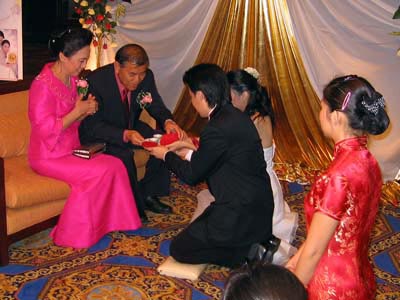Traditionally, after the parents of the bride and groom has agreed to the marriage arrangement based on the compatibility of their astrological signs, birth dates, and family backgrounds, the actual wedding planning can begin.
The families will consult the Chinese almanac for an auspicious wedding date and then consult a fortune teller to see if the date and time of the wedding will bring fortune to the couple  and family. Once the date is set, the place can be determined by the family. Usually in a wedding between prosperous families, the wedding ceremony is held in the groom's house. It is considered one of the most important days for the groom's family, so all of the family's relatives, friends, employees, and even villagers can be invited to this big day. Invitations for the wedding are sent out in a red envelope with gold writing.
and family. Once the date is set, the place can be determined by the family. Usually in a wedding between prosperous families, the wedding ceremony is held in the groom's house. It is considered one of the most important days for the groom's family, so all of the family's relatives, friends, employees, and even villagers can be invited to this big day. Invitations for the wedding are sent out in a red envelope with gold writing.
On the bride's side, the family will have to get the bride's dowry ready to be delivered to the groom's home. This dowry often includes a Chinese hope chest containing domestic linens and bedding such as silk comforter and matching pillowcases bundled together with a strip of red good luck paper. A set of dinnerware, complete with serving platters, soup tureens, a tea set, and chopsticks, is also packed into the dowry. In additional to furnishing, a monetary gift is enclosed to purchase other things for the new home. The final item in the dowry is a Chinese lacquered tray, known as the Good Fortune Tray, filled with lychees, longans, peanuts, dried red dates, and sweets such as sugared coconut, melon, lotus seeds, and ginger. This tray symbolizes good fortune to the future couple. All these possessions will be delivered the groom's house three days prior to the wedding day.












